
Mario Bava was an Italian filmmaker who worked variously as a director, cinematographer, special effects artist and screenwriter. His low-budget genre films, known for their distinctive visual flair and stylish technical ingenuity, feature recurring themes and imagery concerning the conflict between illusion and reality, as well as the destructive capacity of human nature. Widely regarded as a pioneer of Italian genre cinema and one of the most influential auteurs of the horror film genre, he is popularly referred to as the "Master of Italian Horror" and the "Master of the Macabre".

Jesús Franco Manera, also commonly known as Jess Franco, was a Spanish filmmaker, composer, and actor, known as a highly-prolific director of low-budget exploitation and B-movies. He worked in many different genres during his career, but was best known for his horror and erotic films, often incorporating surrealist elements.
Timothy Ray Lucas is an American film critic, biographer, novelist, screenwriter and blogger, best known for publishing and editing the video review magazine Video Watchdog.
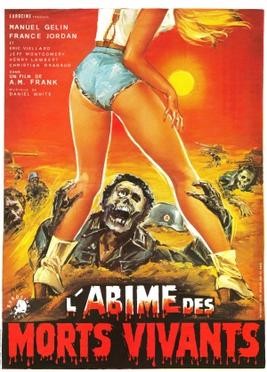
Oasis of the Zombies is a 1982 horror film written, scored, edited and directed by Jesús Franco. A co-production of France and Spain, two different versions of the film were made, each featuring different actors.

Shock Waves is a 1977 American horror film written and directed by Ken Wiederhorn. The film is about a group of tourists who encounter aquatic Nazi zombies when they become shipwrecked. It stars Peter Cushing as a former SS commander, Brooke Adams as a tourist, and John Carradine as the captain of the tourists' boat.
Monsters HD was a 24 hour, seven-days-a-week, linear horror film and monster movie network. It was launched on October 1, 2003, in the United States and premiered exclusively on the Voom DTH satellite platform, owned by Cablevision. The home theatre webzine, Widescreen Review, alluded to Voom's Monsters HD as having "the largest collection of HD Horror films" when Echostar's Dish Network picked up Rainbow Media's Voom Suite of High Definition Channels. Rainbow Media's AMC Network and its annual October "Monsterfest" programming of horror films served as the springboard and promotional platform for the launch of Monsters HD. Monsters HD commissioned the digital restoration of its film library, bringing them to high definition, and presented world television premieres of films like the Director's Cut of the Stuart Gordon film version of H.P. Lovecraft's From Beyond.
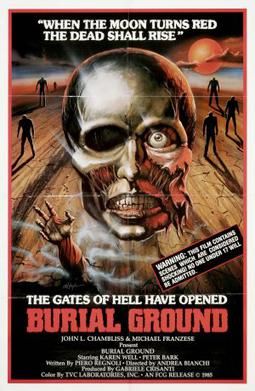
Burial Ground is an Italian exploitation zombie movie directed by Andrea Bianchi. It is one of several films released under the alternative title of Zombie 3.
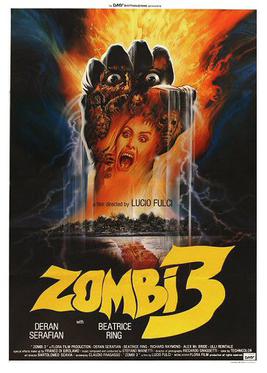
Zombi 3 is a 1988 Italian horror film directed by Lucio Fulci and Bruno Mattei and starring Deran Sarafian, Beatrice Ring, and Ottaviano Dell'acqua. The film is an in-name-only sequel to Fulci's Zombi 2. The film is about a group of scientists at a top-secret research facility who are working on a biological weapon called Death One, which mutates and kills the living creatures and reanimates the dead. The weapon is leaked out of the facility, which leads to a spread of infection among soldiers and touring people in the area.

The Midnight Hour is a 1985 American made-for-television comedy horror film directed by Jack Bender and starring Shari Belafonte-Harper, LeVar Burton, Peter DeLuise, and Dedee Pfeiffer. Its plot focuses on a small New England town that becomes overrun with zombies, witches, vampires, and all the other demons of hell after a group of teenagers unlocks a centuries-old curse on Halloween.

Vengeance of the Zombies is a 1972 Spanish horror film directed by León Klimovsky and starring Paul Naschy, Mirta Miller, Vic Winner and Aurora de Alba. The film was shot in July 1972, but was only theatrically released in Spain in June 1973. It was shown in Italy as La Vendetta dei Morti Viventi. The film was shown in Germany over the years under three different titles....Rebellion of the Living Dead, Invocation of the Devil and Blood Lust of the Zombies.
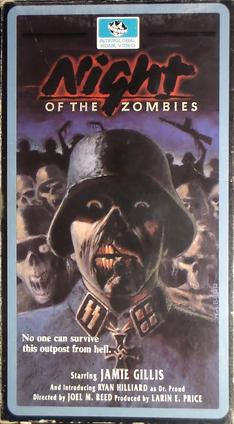
Night of the Zombies is a 1981 American zombie horror war film directed by Joel M. Reed. The film was produced by Lorin E. Price. The film was distributed on VHS by InterGlobal Video Promotions Ltd.

Nazi zombies are a horror trope found in films, video games, and comic books. Nazi zombie narratives usually feature undead Nazi soldiers resurrected to fight for the Third Reich. The book Nazisploitation!: The Nazi Image in Low-Brow Cinema and Culture described the genre as a small theme of horror films.

The Vineyard is a 1989 American horror film directed by James Hong and William Rice, written by Hong, Douglas Kondo, James Marlowe and Harry Mok, and starring Hong, Michael Wong, Sherri Ball and Playboy Playmate Karen Witter.

Die You Zombie Bastards! is a 2005 American superhero comedy horror film directed by Caleb Emerson, written by Emerson and Haig Demarjian, and starring Tim Gerstmar, Geoff Mosher, and Pippi Zornoza. It is about a serial killer (Gerstmar) who must save his cannibal wife Violet (Zornoza) from zombies animated by Baron Nefarious (Mosher).

Virgin Among the Living Dead is a film directed by Jesús Franco. Franco shot the film in Portugal in 1971 with the film it was only being released to the public in 1973. While credited as a production of Liechtenstein, it was submitted theatrically as being the product of various countries with Franco biographer suggesting that the Prodif Ets. company was set up as a tax shelter.

Zombie Massacre is a 2013 horror film written and directed by Luca Boni and Marco Ristori. Uwe Boll served as producer and acted within the film in the role of President of the United States. The film stars ex-bodybuilder Christian Boeving, Mike Mitchell, and Tara Cardinal, and is an adaptation of the Wii video game of the same name, developed by 1988 Games. The film had its UK DVD release on July 1, 2013. The sequel, Zombie Massacre 2: Reich of the Dead, was released in 2015.
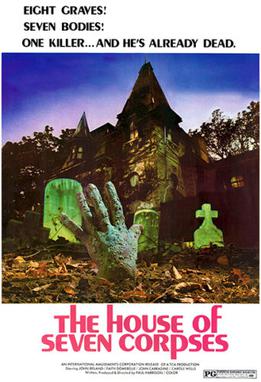
The House of Seven Corpses is a 1973 American horror film directed by Paul Harrison and starring John Ireland, Faith Domergue and John Carradine.
The horror films of Europe were described by Ian Olney in Euro Horror: Classic European Horror Cinema in Contemporary American Culture as often being more erotic and "just plain stranger" than their British and American counterparts. European horror films draw from distinctly European cultural sources, including surrealism, romanticism, decadent tradition, early 20th century pulp-literature, film serials, and erotic comics. Compared to the narrative logic in American genre films, these films focused on imagery, excessiveness, and the irrational.















